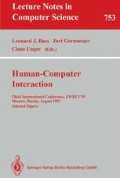Abstract
Multimedia interfaces are currently created by intuition. Development of a method for analysis and design of multimedia presentation interfaces is described. The study investigates task based information analysis, persistence of information, selection attention and concurrency in presentation. The method gives an agenda of issues, diagrams and techniques for specification, and guidelines for media selection and presentation scripting. Use of the method is illustrated with a case study of shipboard emergency management.
The help of Lloyds Register, UK is gratefully acknowledged. Thanks in particular to Clive Bright, John Hobday and Derek Rhoden of Lloyds.
Preview
Unable to display preview. Download preview PDF.
References
J. Alty & C.D.C. McCartney: Design of a Multi-media Presentation System for a Process Control Enviroment. Eurographics Multimedia workshop: Stockholm (1991)
E. Andre & T. Rist: Generating Illustrated Documents: A plan based approach. InfoJapan 90, Vol 2, 163–170 (1990)
D.J. Bartram: Comprehending spatial information: The relative efficiency of different methods of presenting information about bus routes. Journal of Applied Psychology, 65, 103–110 (1980)
R. Becklem & D. Cervone: Selective looking and the noticing of unexpected events. Memory & Cognition, 11(6), 601–608 (1983)
G.R. Bieger & M.D. Glock: The Information Content of Picture-Text Instructions. Journal of Experimental Education, 53, 68–76 (1984)
H.R. Booher: Relative Comprehensibility of Pictorial Information and Printed word in Proceduralized Instructions. Human Factors, 17(3), 266–277 (1975)
S. Fiener & K.R. McKeown: Generating Co-ordinated Multimedia Explanations. In 6th IEEE Conference on Artificial Intelligence Applications (Santa Barbara CA) (Pg 290–296) (1990)
T. Grimes: Mild Auditory-Visual dissonance in TV News may exceed viewer attention. Human Communication Research 18(2) 268–298 (1991)
G.J. Hitch: Working memory. In B. Christie & M. Gardiner (eds.): Applying cognitive psychology to user interface design. London: J. Wiley (1987)
P. Johnson, H. Johnson, R. Waddington, & A. Shouls: Task-Related Knowledge Structures: Analysis. Modelling and Application. In D.M. Jones, R. Winder (eds.): People and Computers IV. Cambridge University Press. (1988)
J.B. Long & J. Dowell: Conceptions of the Discipline of HCI: Craft, Applied Science and Engineering. In A.G. Sutcliffe, L. Macaulay (eds.): People and Computers V., Cambridge University Press. (1989)
W.C. Mann & S.A Thompson: Rhetorical Structure Theory — Toward a functional theory of text organisation. Text, 8(3), 243–281 (1988)
M. Maybury: Planning Multimedia Explanations Using Communicative Acts. In Proceedings of 9th National Conference on Artificial Intelligence (Pg 61–66) (1991)
J. Miller: Timecourse of coactivation in bimodal divided attention. Perception & Psychophysics, 40(5), 331–343 (1986)
D. Navon & J. Miller: Role of Outcome Conflict in Dual Task Interference. Journal of Experimental Psychology: Human Perception and Performance, 13(3), 435–448(1987)
M. Petre & T.R.G. Green: Is graphical notation really superior to text, or just different ? Some claims by logic designers about graphics in notation. In Fifth European Conference on Cognitive Ergonomics (Urbino, Italy) (1990)
M. Posner: Visual Dominance: An Information Processing account of its origins and significance. Psychological Review, 83, 157–171 (1976)
L.P. Rieber: Animation in Computer Based Instruction. Educational Technology Research & Development, 38, 77–86 (1990)
J.R Searle: Speech Acts: An essay in the philosophy of language. Cambridge University Press (1969)
C.D. Wickens: Processing Resources in Attention. In R. Pararsuraman & D. Davies (eds.): Varieties of Attention (Pg 63–102). New York: Academic Press (1983)
Author information
Authors and Affiliations
Editor information
Rights and permissions
Copyright information
© 1993 Springer-Verlag Berlin Heidelberg
About this paper
Cite this paper
Sutcliffe, A., Faraday, P. (1993). Designing multimedia interfaces. In: Bass, L.J., Gornostaev, J., Unger, C. (eds) Human-Computer Interaction. EWHCI 1993. Lecture Notes in Computer Science, vol 753. Springer, Berlin, Heidelberg. https://doi.org/10.1007/3-540-57433-6_42
Download citation
DOI: https://doi.org/10.1007/3-540-57433-6_42
Published:
Publisher Name: Springer, Berlin, Heidelberg
Print ISBN: 978-3-540-57433-0
Online ISBN: 978-3-540-48152-2
eBook Packages: Springer Book Archive

